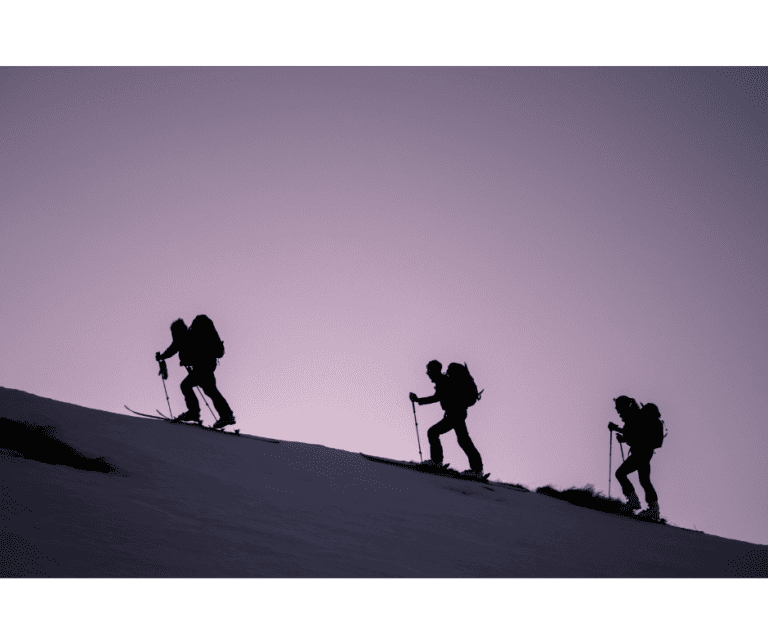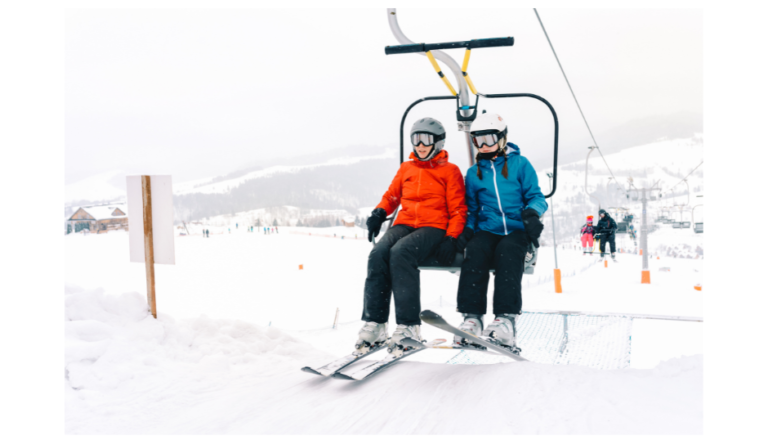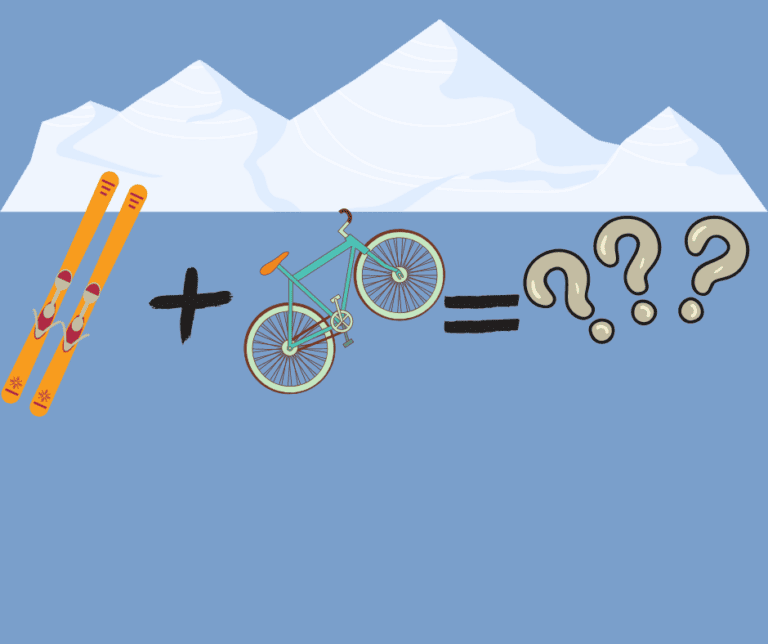Nordic vs. Alpine Skiing: What’s Are The Key Differences?

Living in Svalbard, where pristine snowfields are as common as daylight during polar summer, skiing is not just a sport but a way of life for locals. Originally a practical means to cross snow-covered terrains, skiing has evolved into a diverse leisure activity, branching into Alpine and Nordic forms. Alpine skiing offers the exhilarating rush of speeding downhill, while Nordic skiing challenges the endurance of cross-country travel.
In this article, I’ll share insights into these two distinct skiing experiences, highlighting their differences and helping you decide which snowy adventure might best suit your preferences. If you are a beginner skier, read my comprehensive article about how to ski as a beginner.
For a quick reference on the distinctions between Nordic and Alpine skiing, refer to the concise comparison table below the key takeaway section.
Key Takeaways
Comparison Table
| Factor | Alpine Skiing | Nordic Skiing |
|---|---|---|
| Terrain | Steep, groomed slopes at ski resorts | Flatter, often ungroomed cross-country trails |
| Technique | Downhill speed, carving turns | Endurance, straight gliding, and side-to-side skating |
| Equipment | Wider, shorter skis with fixed heels | Longer, narrower skis with free heels |
| Fitness | Strength, balance, agility | Cardiovascular endurance, full-body workout |
| Atmosphere | Social, lively resorts | Peaceful, natural settings |
| Accessibility | Mountainous regions | Varied landscapes, often accessible |
| Skill Level | Steeper learning curve | Generally easier for beginners |
| Cost | More expensive due to gear and lift tickets | Less expensive, many trails are free |
What Is Nordic Skiing?

Nordic skiing is more than just a sport; it’s a connection to a tradition that dates back thousands of years, originating as a practical means of transportation across the snow-laden landscapes of Scandinavia. Today, it has evolved into both a competitive sport and a cherished recreational activity, celebrated from the snow-capped expanses of the Arctic to the world stage of the Olympics.
In Nordic skiing, the terrain typically consists of rolling landscapes, often with a mixture of flat sections, gentle inclines, and sometimes steep hills. It’s a versatile sport that can take you from groomed trails to untouched backcountry.
Equipment for Nordic Skiing
The equipment used in Nordic skiing is specifically designed to cater to this varied terrain:
- Skis: Longer and narrower for efficient glide, with a lightweight construction to handle long distances. They have a lighter construction, often featuring a cambered design that arches in the middle to enhance glide and grip when weight is distributed evenly.
- Bindings: The bindings are unique in that they secure only the toe of the boot, leaving the heel free to lift allowing for a full range of motion necessary for the striding techniques used in Nordic skiing. There are two main types of Nordic bindings: classic and skate. Classic bindings are designed for a straight-ahead motion, while skate bindings allow for a side-to-side skating motion, similar to ice skating.
- Boots: Unlike the stiff, heavy boots of Alpine skiing, Nordic boots are more like sturdy winter shoes, allowing the ankle to flex naturally which enables the skier to navigate varying terrain efficiently. They are insulated to protect against the cold and are compatible with the bindings to ensure a secure fit.
- Boot attachment: Boots are connected to the bindings at the toes, with heels free to lift, which is essential for both the classic and skate skiing techniques. This allows for the necessary push-off for forward movement, especially noticeable when ascending.
- Poles: They are generally longer than Alpine poles to aid in propulsion, especially on flat and uphill sections. The poles are planted behind the body and used to push off, while in skate skiing, they’re used more dynamically to aid in a lateral skating motion.
Nordic Skiing Styles and Techniques
- Classic Cross-Country: The traditional form of Nordic skiing, where skiers move with a straight-ahead gliding motion, using tracks set in the snow. The key techniques include the diagonal stride, which is the fundamental movement, double poling for flat sections or downhills, and the herringbone technique for going uphill without slipping backward.
- Skate Skiing: A newer style that resembles ice skating, where skiers push off with the edges of their skis in a V-shaped pattern. Techniques include the V1, which is used for climbing hills, with a single pole push for every ski push-off; the V2, a faster technique for moderate terrain with a double pole push for each alternating skate; and the V2 Alternate, used on flats and slight downhills, with a double pole push for every other skate.
- Telemark: Combines elements of Alpine and Nordic skiing, using free-heel bindings and a distinctive lunging turn. The telemark turn is the signature move, where one ski is placed in front of the other with a bent knee in a lunging motion, allowing turns on steep terrain.
- Biathlon: A combination of cross-country skiing and rifle shooting. The cross-country skiing techniques used are similar to classic style, but athletes must also master the transition to and from the shooting range as well as maintaining steady breathing and calm for accurate shooting.
- Ski Orienteering: Involves navigation across varied terrain using a map and compass while skiing. Skiers use classic or skate skiing techniques, but must also be adept at reading maps and making quick decisions on the best routes while skiing at pace.
What Is Alpine Skiing?
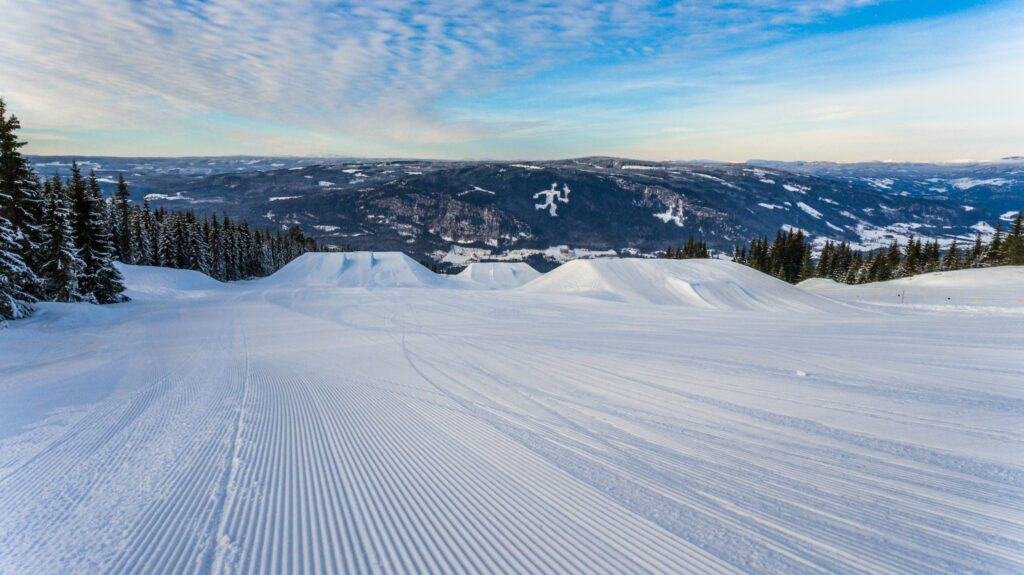
Alpine skiing, or downhill skiing, is primarily practiced on steep, snow-covered slopes within mountainous terrain. It’s a sport that thrives on gravity and the challenges of navigating diverse downhill landscapes.
Alpine skiing terrain typically includes groomed trails, off-piste areas, and challenging downhill courses with varying steepness and complexity. You can visit the ski.com website to find the best ski resort of your interest.
Equipment for Alpine Skiing
- Skis: The equipment is designed for speed and stability. Alpine skis are wider and shorter than Nordic skis, providing better traction and maneuverability. The width underfoot varies, accommodating different styles from racing to free-riding, which directly influences grip on hard-packed snow and response in deep powder. The sidecut of the skis, or the hourglass shape, enables skiers to initiate and carve turns with precision, crucial for managing speed and direction on steep slopes.
- Bindings: The role of Alpine ski bindings is twofold: they must provide a steadfast connection between boot and ski to allow for precise control during aggressive turns and high-speed descents. Yet, they’re also built with a release mechanism that is calibrated to the skier’s weight, skill level, and preferences. This safety feature is designed to reduce the risk of injury by releasing the boot during a significant fall or when abnormal force is applied, allowing the skier to separate from their skis.
- Boots: Alpine boots are rigid and secure, offering protection and precise energy transfer from the skier to the skis. The snug fit, often customizable with heat-moldable liners, and the robust buckling systems provide a secure environment that maximizes energy transfer without sacrificing safety. The stiffness of the boot, quantified by the flex rating, is tailored to the skier’s ability and style—stiffer for racing and softer for all-day comfort.
- Boot Attachment: Boots in Alpine skiing are attached firmly; the boots click into the bindings, and the skier’s heel is locked down. This connection allows for the transfer of precise movements to the skis, which is especially important when edging during turns and maintaining maximum control at high speeds. The secure attachment means that skiers can confidently lean into their turns and trust their equipment to respond instantly.
- Poles: Poles are used for balance and timing rather than propulsion, aiding in sharp turns and maintaining rhythm. In powder, they help skiers to maintain balance and to gauge the depth of the snow. The length of the pole is important, too—it should be just right to allow for a comfortable arm position.
Alpine Skiing Styles and Techniques
The Alpine-style is aggressive and dynamic, with powerful turns and swift descents. Skiers use carving techniques to navigate the slopes. There are several types, each with its own techniques and gear:
- Downhill: Focused on speed, it involves skiing down the longest and steepest courses in Alpine racing. Techniques focus on a strong, athletic stance, precise edging to control speed, and tucking to minimize air resistance.
- Slalom: Involves quick, short swings and turns around poles or gates, demanding agility and technical precision. Techniques include rapid leg and edge movements, cross-blocking (where a skier uses their arm to push the gate down), and maintaining a fluid rhythm.
- Giant Slalom: A form of slalom with wider turns and greater speeds, serving as a midpoint between downhill and slalom. Skiers employ dynamic weight transfer, early edge engagement, and powerful pole plants to navigate the course.
- Super-G: Combines the speed of downhill with the technical turns of a giant slalom, requiring both precision and control at high velocity. Skiers must adapt techniques on the fly, adjusting stance and turn shape to handle varying terrain and gate setups.
- Freestyle: Includes acrobatic maneuvers such as jumps, flips, and spins, often performed in terrain parks. Techniques include take-off precision, air control, and safe landings, with a focus on balance and core strength.
Alpine skiing demands both physical strength and technical skill, offering a thrilling experience that’s as much about the mastery of equipment and terrain as it is about the sheer joy of the descent.
Comparing Alpine and Nordic Skiing
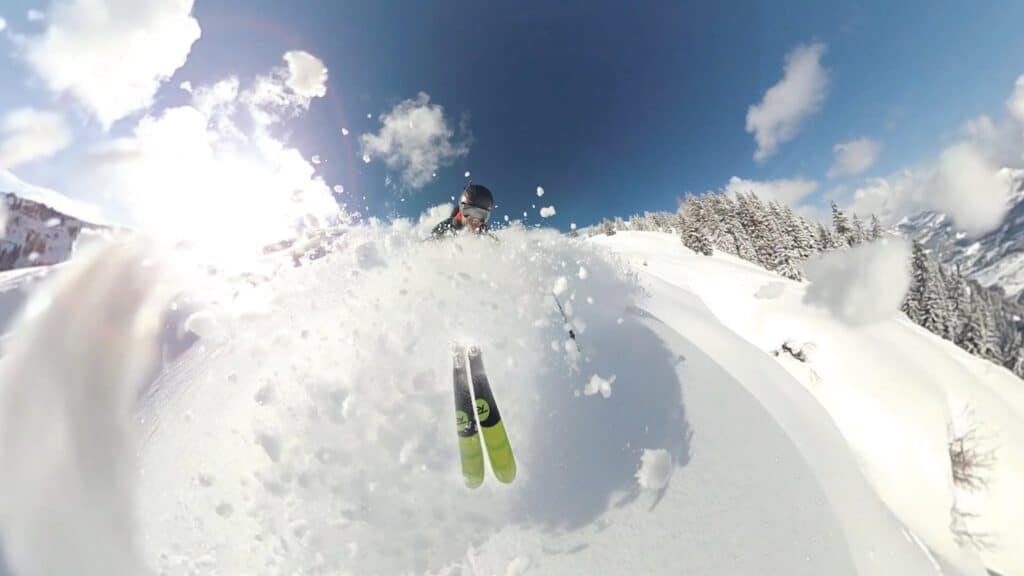
The key differences between Nordic and Alpine skiing can be distilled into four main categories: terrain, styles, equipment, and clothing.
1. Terrain
Alpine skiing is predominantly practiced on well-maintained ski resorts with marked trails, featuring slopes that vary from gentle inclines to challenging steep descents. The terrain is often sculpted to enhance the skiing experience, with features like moguls and terrain parks. Nordic skiing, on the other hand, generally takes place on flatter terrain which can range from meticulously groomed tracks to back-country routes. It’s common to find Nordic trails winding through forests and across open fields, accommodating both the leisurely pace of classic skiing and the intensity of skate skiing.
2. Styles
In Alpine skiing, the style revolves around the thrill of descending slopes. Skiers use gravity to their advantage, executing turns and jumps. The style is more about the quick maneuvers, carving turns, and sometimes even aerial tricks in freestyle disciplines. Nordic skiing, conversely, involves a variety of styles that all focus on horizontal travel. Classic Nordic skiing uses a straight-ahead motion, while skate skiing involves a side-to-side motion similar to ice skating. Each style requires a distinct technique and approach to effectively traverse the landscape.
3. Equipment
Alpine equipment is designed for control at high speeds and quick turns. Skis are typically wider for stability in various snow conditions and shorter for maneuverability. Bindings securely attach the boot to the ski at both toe and heel. Nordic equipment is designed for efficiency over long distances. Skis are lighter and more flexible, bindings allow the heel to lift, and boots are more akin to rugged hiking shoes in terms of flexibility and comfort.
4. Clothing
Alpine skiing clothing is engineered to resist the cold and wind encountered during high-speed descents. This often means thicker, more insulated garments, as well as waterproof and windproof outer layers. Helmets, goggles, and sometimes face masks are also necessary for protection against the elements and potential falls. For Nordic skiing, the clothing is designed for aerobic activity, offering breathability and allowing for a greater range of motion. It’s common for Nordic skiers to layer their clothing to manage body temperature as they exert themselves over time.
Both worlds offer their own distinct communities: Alpine with its resort-based camaraderie and Nordic with its close-knit trail networks, each with a shared passion for the joys of skiing under a blanket of snow.
What To Consider When Choosing Between Nordic and Alpine Skiing

- Fitness Level and Goals: Nordic skiing is a full-body workout known for its cardiovascular benefits. If endurance and fitness are your goals, Nordic may be more suitable. Alpine skiing requires strength, balance, and quick reflexes, focusing more on speed and agility.
- Terrain Preference: Alpine skiing is confined to slopes and resorts, ideal for those who love the thrill of downhill speed. Nordic skiing allows you to traverse varied terrain, from flat tracks to rolling hills and is often done in more natural, serene settings.
- Social Aspect: Alpine skiing tends to offer more social opportunities with resorts, ski schools, and après-ski activities. Nordic skiing can be more solitary or in small groups, often in quieter, less crowded environments.
- Equipment and Cost: Alpine gear tends to be more expensive due to the specialized boots, bindings, and often the cost of lift tickets. Nordic equipment is generally less costly and may not require a lift ticket, as many trails are free to access.
- Skill Development: Beginners may find Nordic skiing easier to start with due to the slower speeds and flatter terrain. Alpine skiing has a steeper learning curve with the need for more technique and control at higher speeds.
- Accessibility: Consider the proximity to mountains for Alpine skiing versus the availability of flat trails for Nordic skiing.
- Personal Preference: Ultimately, it comes down to personal preference. Some enjoy the high-energy atmosphere of Alpine skiing, while others prefer the peacefulness and rhythm of Nordic skiing.
Fitness and Training Requirements for Nordic and Alpine Skiing
Nordic and Alpine skiing, while both exhilarating winter sports have distinct physical demands and training requirements. Understanding these can help enthusiasts and beginners prepare effectively for each style.
Nordic Skiing:
- Endurance and Cardiovascular Fitness: Nordic skiing, especially cross-country, is akin to long-distance running. It requires excellent cardiovascular endurance. Activities like running, cycling, and swimming in the off-season can build the necessary stamina.
- Full-Body Strength and Balance: This style engages the entire body, requiring good core strength and balance. Core-strengthening exercises, Pilates, and yoga can be beneficial.
- Flexibility: To optimize stride and prevent injuries, flexibility is key. Regular stretching and mobility exercises should be part of the training regimen.
- Specific Skill Training: Techniques such as double poling, diagonal stride, and skate skiing require practice. Roller skiing is a popular off-snow training method to hone these skills.
Alpine Skiing:
- Leg Strength and Power: Alpine skiing predominantly utilizes the lower body. Exercises like squats, lunges, and plyometrics are crucial for building leg strength and power.
- Agility and Quick Reflexes: Maneuvering down slopes at high speeds demands agility. Drills that enhance reflexes and coordination, such as slalom running or agility ladder workouts, are beneficial.
- Core Stability: A strong core is essential for maintaining balance and control. Stability workouts and core exercises are important components of training.
- Anaerobic Capacity: Unlike Nordic skiing, Alpine skiing relies more on short bursts of high-intensity effort. Interval training can be an effective way to build anaerobic capacity.
Both disciplines benefit from a well-rounded fitness approach that includes cardiovascular endurance, strength, flexibility, and specific skill training. Additionally, both types of skiers should incorporate pre-season and in-season training routines that focus on not only building the required physical capabilities but also on preventing injuries.
Popular Destinations for Nordic and Alpine Skiing
Both Nordic and Alpine skiing offer unique experiences and breathtaking landscapes. Here’s a guide to some of the world’s most renowned destinations and resorts for both styles, appealing to those planning skiing trips.
Nordic Skiing Destinations:
- Cross-Country Skiing in Trondheim, Norway: Norway is considered the birthplace of Nordic skiing. Trondheim offers extensive trails with beautiful scenery, suitable for all skill levels.
- Lapland, Finland: Known for its vast wilderness, Lapland provides an idyllic backdrop for cross-country skiing, with trails winding through snow-laden forests and alongside frozen lakes.
- Lake Placid, New York, USA: Famous for hosting the Winter Olympics, Lake Placid has well-groomed trails and offers a variety of terrains for Nordic skiing.
- St. Moritz, Switzerland: Offering a blend of luxury and pristine nature, St. Moritz’s extensive network of trails is a paradise for cross-country skiers.
Alpine Skiing Destinations:
- Chamonix, France: Nestled in the Alps, Chamonix is famed for its challenging slopes and breathtaking views, suitable for experienced Alpine skiers.
- Whistler Blackcomb, Canada: One of North America’s largest ski resorts, it features diverse terrain, making it a haven for skiers of all levels.
- Aspen, Colorado, USA: Known for its four ski areas, Aspen caters to both beginners and experts, with its mix of rugged terrain and well-groomed runs.
- Kitzbühel, Austria: Renowned for hosting the Hahnenkamm, one of the most challenging downhill races, Kitzbühel offers a mix of historical charm and world-class skiing.
Conclusion
Alpine skiing lets you experience the thrill of climbing slopes, the rush of descending, and the lively culture of ski resorts. It’s a dance of speed and agility, a test of your strength against the pull of gravity. Nordic skiing, on the other hand, is a more peaceful way to connect with nature. It’s a test of endurance that takes place on quiet snowy plains. The beauty of each is different, and trying both can help you appreciate the wide range of snowboarding styles. Reflecting on my own experiences, the crisp air and the freedom of the slopes remind me that skiing is more than a sport—it’s an adventure that enlivens the soul.
FAQs
What are the main physical differences between Nordic and Alpine skis?
Nordic skis are typically longer and narrower with bindings that only secure the toes, allowing the heel to lift for a striding motion. Alpine skis are wider and shorter with bindings that secure both the toe and heel, providing stability and control for downhill skiing.
Can I use Alpine skiing techniques in Nordic skiing, or vice versa?
Not really. The techniques used in Alpine and Nordic skiing are quite distinct due to the differences in terrain and equipment. Alpine skiing focuses on downhill maneuvers and turns, while Nordic skiing involves endurance and gliding on flatter terrain.
Is Nordic or Alpine skiing better for beginners?
It depends on the individual’s interests and physical fitness. Nordic skiing might be easier to start with due to its gentler terrain and endurance-based technique. However, those interested in downhill skiing and quick turns might prefer to start with Alpine skiing.
What type of fitness benefits can I expect from Nordic and Alpine skiing?
Nordic skiing provides a full-body workout, emphasizing cardiovascular endurance. Alpine skiing, while also physically demanding, focuses more on strength, balance, and agility due to the nature of downhill skiing.
Are there different types of equipment needed for each style of skiing?
Yes, the equipment for Nordic and Alpine skiing differs significantly. Besides the skis, Nordic skiing often requires lighter, more flexible boots and poles that are longer than those used in Alpine skiing. Alpine skiing equipment is designed for downhill control, with stiffer boots and shorter poles.


